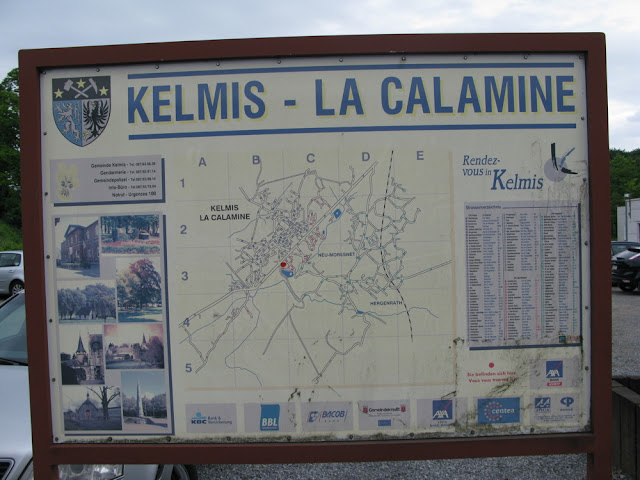2 June 2012: Book launch and exploration of former Amikejo
Mon, Jun 18 2012
On June 2, after having visited Manifesta 9, we took the route towards the Belgian city of Kelmis-La Calamine, nearby the German and Dutch border, where we planned to launch the 'Amikejo' publication (Mousse Publishing, 2012) later that day.
Entrance to Kelmis-La Calamine. Trying to match today with the archive material included in the publication.

"The International Office for Travelling Merchants (‘Senpaga Internacia Oficejo por Komerco-Vojagxistoj’) was located in the Bergerhoff Hotel." (Hotel Bergerhoff was located on Luikerstraat, formerly Hasardstraat, in the place which today accommodates the ‘Select’ Café in Kelmis.)" in Ryszard Żelichowski, "Neutral Moresnet and Amikejo – The Forgotten Children of the Congress of Vienna", one of the texts in 'Amikejo' (Mousse Publishing, 2012. Edited by Latitudes).

"There were as many as 135 registered Esperantists in a population then numbering four thousand. The Esperantists enjoyed the right to have two free Esperanto lessons in a primary school on Kerkstraat, which was a present to the city from the Vieille Montagne mining company. [Mr Charles] Schriever gave four lessons of Esperanto a week for children in his house on Kapelstraat, where there was a book shop with literature in Esperanto. The house also functioned as an office for the local Esperanto group and the venue for its meetings. The Esperantists’ guest houses were marked with a green star on their facades and the caption ‘Esperanta Gasttablo’; some of them survive to this day.
What is now Park Hotel in Kelmis, built in 1843, was once the Vieille Montagne Director’s villa. Situated in a beautiful private park and with a huge ball-room, it was presented to the Esperantists by Charles Timmerhaus, the penultimate Director of the company, in 1907." in Ryszard Żelichowski, "Neutral Moresnet and Amikejo – The Forgotten Children of the Congress of Vienna", one of the texts in 'Amikejo' (Mousse Publishing, 2012. Edited by Latitudes).
Finding our way around Kelmis-La Calamine.
Welcome to Kelmis–La Calamine.
Façade of the Geuldalmuseum, Göhltalmuseum or Musée de la Vallée de la Gueule (how confusing) on Maxst. 9, Kelmis/Neu-Moresnet, Belgium. Info here. A copy of the publication 'Amikejo' (Mousse Publishing, 2012. Edited by Latitudes) was donated to the museum's archive on our visit.
Detail of the topological map of the area. In red the Drielandenpunt, towards Aachen, where we'd be going after visiting the museum.
Map of the triangular-shapped territory of Neutral Moresnet (Amikejo) in yellow and green.
First floor: Introduction to Neutral Moresnet, the first Esperanto state. Those who spoke Esperanto wore a green star (verda stelo). In the picture avid Esperantists Dr. Wilhelm Molly and french professor Gustave Roy, who in 1908 founded the first esperanto state (Amikejo, place of friendship in Esperanto) in Neutral-Moresnet. Summary of its history here.
Wonderful panels explaining the history of Amikejo, its streets,
founders, borders, flag, postcards, maps, stamps, coins, certificates, letters, lyrics of the anthem, coat of arms...
One of the original border markers.
Views of Kelmis–La Calamine and its surroundings.
Flora and fauna of the mining area.
Driving towards Vaals and the Drielandenpunt and going under the viaduct.
Arrived. "The Vaalserberg is also the location of the tripoint between Germany, Belgium and the Netherlands and its summit is therefore referred to as Drielandenpunt ("Three-Country Point") in Dutch, or Dreiländereck ("Three-Country Corner") in German, or Trois Frontières ("Three Borders") in French." (from Wikipedia).
A small mention of Neutral Moresnet (1815–1919, which in 1908 changed its name to Amikejo). Between this period, the location was a quadripoint, bordering also Neutral Moresnet. See progress of the borders here.
The Drielandenpunt today.
Vaalserberg ("Mount Vaals") is 322.7 metres hill and the highest point in the European part of the Netherlands. It used to be like this.
Visitors reading about the drienlandenpunt's history and geographical situation.
Tower from where one can observe Germany, The
Netherlands and Belgium from on high.
The 'Amikejo' book resting on the Drielandenpunt (the apex of the triangle-shaped borders of what was Amikejo). The green lines mark the borders of Germany (whole top), The
Netherlands (triangle to the left) and Belgium (to the right).
All images: Latitudes | www.lttds.org






























